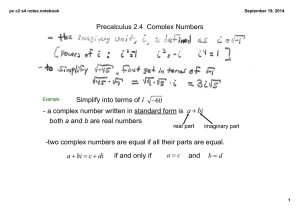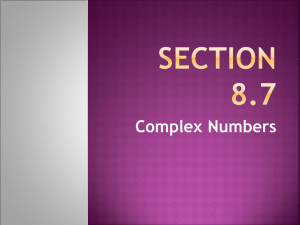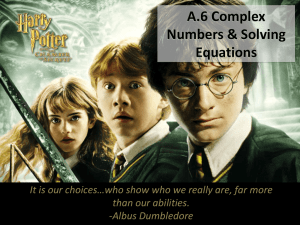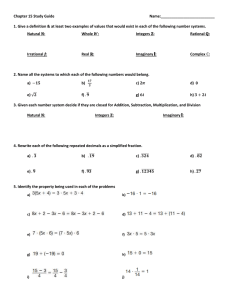1 Complex Numbers
advertisement
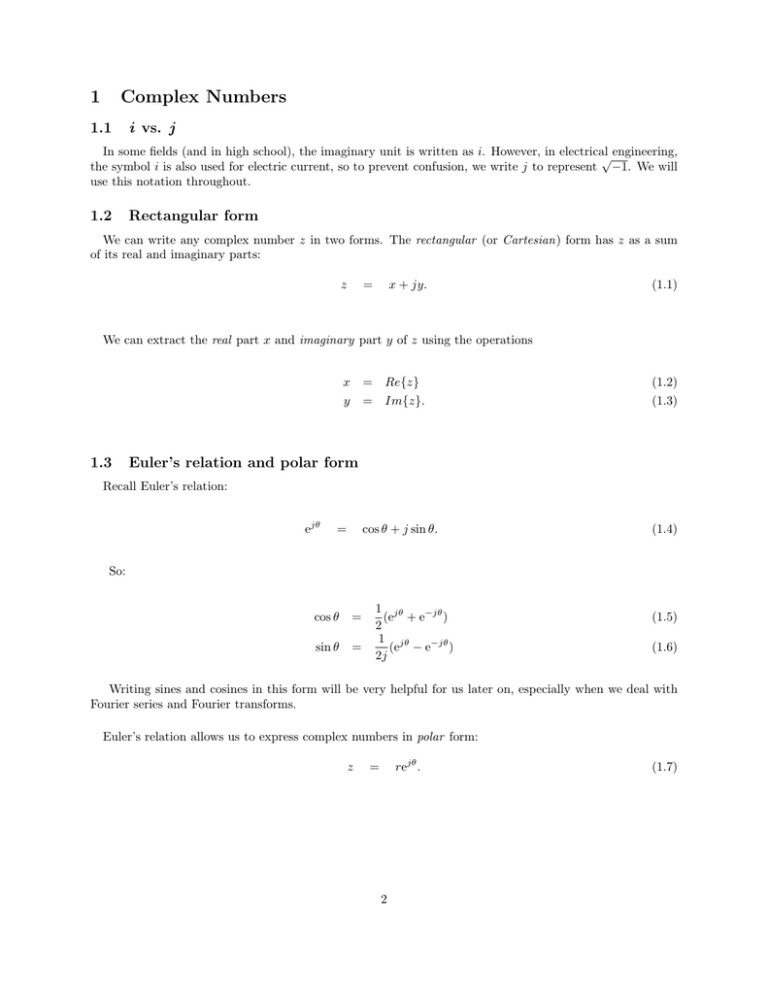
1
Complex Numbers
1.1
i vs. j
In some fields (and in high school), the imaginary unit is written as i. However, in electrical
√ engineering,
the symbol i is also used for electric current, so to prevent confusion, we write j to represent −1. We will
use this notation throughout.
1.2
Rectangular form
We can write any complex number z in two forms. The rectangular (or Cartesian) form has z as a sum
of its real and imaginary parts:
z
x + jy.
=
(1.1)
We can extract the real part x and imaginary part y of z using the operations
1.3
x = Re{z}
(1.2)
y
= Im{z}.
(1.3)
cos θ + j sin θ.
(1.4)
Euler’s relation and polar form
Recall Euler’s relation:
ejθ
=
So:
cos θ
=
sin θ
=
1 jθ
(e + e−jθ )
2
1 jθ
(e − e−jθ )
2j
(1.5)
(1.6)
Writing sines and cosines in this form will be very helpful for us later on, especially when we deal with
Fourier series and Fourier transforms.
Euler’s relation allows us to express complex numbers in polar form:
z
rejθ .
=
2
(1.7)
We can extract the magnitude (or absolute value or modulus) r and angle (or phase or argument) θ of z
using the operations
r
θ
= |z|
= ∠z = arg{z}.
(1.8)
(1.9)
The components of the two forms are related by
r
=
tan θ
=
x2 + y 2
y
.
x
(1.10)
(1.11)
The following diagram shows the complex number z = a + jb = rejθ in the complex plane:
Im
y
r
θ
Re
x
The complex conjugate of a complex number z is the complex number z ∗ (also written z) whose imaginary
part is the opposite of the imaginary part of z. So, if
z
=
x + jy
=
ejθ
(1.12)
z∗
=
x − jy
=
e−jθ
(1.13)
then
An easy way to take the conjugate of a complicated arithmetic expression containing complex numbers
is to replace all the j’s with −j’s. The conjugate is an alternative method for determining the magnitude of
a complex number:
|z|2
=
3
z∗z
(1.14)
We can use the complex conjugate to extract the real and imaginary parts of a complex number z:
1
(z + z ∗ )
2
1
(z − z ∗ )
2j
Re{z} =
Im{z} =
1.4
(1.15)
(1.16)
Continuous phase vs. principal value of phase
Note that we can add any multiple of 2π to the phase of a complex number z without changing z’s value.
So what happens when we compute arg{ejθ }? Is it the same as arg{ej(θ+2π) }? This question isn’t a big deal
right now, but later, when we take the phase of a function (such as the Fourier transform), we will need to
distinguish between the continuous phase (denoted by arg{}), which ensures that the phase is a continous
function, and the principal value of the phase (denoted by ARG{}), where the returned phase θ satisfies
−π < θ ≤ π.
1.5
Complex arithmetic
Suppose we have the complex numbers:
z1 = x1 + jy1 = r1 ejθ1 ,
z2 = x2 + jy2 = r2 ejθ2 ,
(1.17)
(1.18)
where xi , yi , ri and θi are real numbers. Then, we define the sum of z1 and z2 to be the sum of the real
and imaginary parts independently:
Re{z1 + z2 } = Re{z1 } + Re{z1 },
Im{z1 + z2 } = Im{z1 } + Im{z1 }.
(1.19)
(1.20)
This can easily be verified in rectangular form:
z1 + z 2
=
=
(x1 + jy1 ) + (x2 + jy2 )
(x1 + x2 ) + j(y1 + y2 ).
(1.21)
(1.22)
This motivates us to picture complex numbers as vectors: individual components of vectors add independent, just like the real and imaginary components of complex numbers. However, multiplication is a bit
harder to interpret in rectangular form:
z1 z2
=
=
(x1 + jy1 )(x2 + jy2 )
(x1 x2 − y1 y2 ) + j(x1 y2 + y1 x2 )
4
(1.23)
(1.24)
A recurrent problem-solving technique is to switch forms or representations when one becomes difficult to
use. So, let’s try this in polar form:
z1 z2
=
=
r1 ejθ1
r2 ejθ2
(1.25)
(r1 r2 )ej(θ1 +θ2 ) .
(1.26)
Thus, the magnitude of the product of two complex numbers is the product of the magnitude of the factors,
and the angle is the sum of the angles of the factors:
|z1 z2 | = |z1 ||z2 |,
(1.27)
∠{z1 z2 } = ∠{z1 } + ∠{z2 }.
(1.28)
To summarize:
Addition of Multiplication of Complex Numbers: Let
z1 = x1 + jy1 = r1 ejθ1 ,
z2 = x2 + jy2 = r2 ejθ2 ,
(1.29)
(1.30)
be two complex numbers. Then, their sum is:
z1 + z2
=
(x1 + x2 ) + j(y1 + y2 ),
(1.31)
and their product is:
z1 z2 = (x1 x2 − y1 y2 ) + j(x1 y2 + y1 x2 ) = r1 r2 ej(θ1 +θ2 ) .
(1.32)
When we divide complex numbers in rectangular form, we multiply the top and bottom by the conjugate
of the denominator. Likewise, exponentiation is usually done most easily when polar notation is used.
In 6.003, we will be dealing with complex numbers all the time. So, it will be important for you to
be comfortable with switching between rectangular and polar forms as appropriate for a given concept or
problem.
5
Problem 1.1
Try the following exercises to practice working with complex numbers.
(a) Compute √1+j
using both rectangular arithmetic and by converting the problem first into polar form.
3+j
Which method was less painful?
(b) Compute the magnitude and angle of ej + e3j .
√
(c) Simplify ( 3 − j)8 .
∞
(d) Compute 0 e−2t cos(πt) dt.
(e) Write the real part of:
1 − zn
1−z
in terms of the magnitude and phase of z, where n is a positive integer.
(f) What did you learn from this problem?
(Workspace)
6
(1.33)

